Apps
Auto Added by WPeMatico
Auto Added by WPeMatico
Most of the data around web browser market share puts Google Chrome or Safari at the top – with their percentage of the market varying by platform and region. But new research from analytics provider Mixpanel finds that many sources are overlooking a major contributor of mobile web browser events here in the U.S.: Facebook.
According the firm’s new study involving millions of users and billions of events across its platform, Facebook has grown to become a significant browser on U.S. mobile devices. In some states, it’s even accounting for a sizable number of mobile browser events – like Washington (13.74%), Rhode Island (13.14%), and Montana (12.64%), for example.
While Facebook’s use as a mobile browser was still far outweighed by Safari in most cases, due to the dominance of Apple’s iOS in the U.S., the social networking app has achieved mobile browser market share of around 10 percent in many states, Mixpanel found.
This includes: Texas (10.12%), Hawaii (10.94%), New Hampshire (10.52%), Indiana (11.93%), Missouri (11.49%), Pennsylvania (10.92%), South Carolina (10.16%), North Carolina (11.8%), Oregon (9.73%), North Dakota (9.9%), West Virginia (9.95%), Minnesota (11.81%), and Delaware (9.94%), in addition to Washington, Rhode Island, and Montana, as noted above.
This is notable because it means many people in those states are using Facebook as their main point of consuming online content – whether it’s news or entertainment, or anything else.
It’s also indicative of the threat that Google has been facing for some time as users shift their web searches to mobile devices. With more people using Facebook as their portal to the web, Google has had to rely more heavily on partnership deals – like its integration in Apple’s Safari browser where it pays to be the default search engine, creating much heftier traffic acquisition costs.
Facebook’s growth as a mobile browser is also of concern because it means it has an outsized influence on shaping the flow of news and information, without having a news media background or experience – or even, any longer, an editorial staff who curates the way news reaches Facebook users.
Instead, it has for years over-relied on its algorithms to customize the News Feed, which allowed fake news, hoaxes, and clickbait to spread. This is something the company has only recently come to terms with, and is trying to correct through punitive measures like downranking fake news, as well as by implementing fact-checking programs.
Those course corrections are long overdue, and are increasingly critical to get right, as this new data shows.
Thankfully, Facebook’s portion of the mobile browser market share is still small compared with Safari, which has the majority market share in almost all the U.S. states, where it claims anywhere from the mid-50’s to mid-60’s in terms of mobile browser market share percentages.
On average across all U.S. states, Safari claims 58.06 percent of mobile browser market share, Chrome has 32.48 percent, and Facebook has 8.82 percent. All other browsers account for the remaining 0.64 percent, Mixpanel reports.
Related to Safari’s dominance, the study also found iOS topped Android usage in the U.S. with 65.5 percent of American using iOS versus 34.46 percent on Android.
In some states, iOS’ usage was very high – around three-quarters or more of the population are using Apple’s OS – including: Alaska (77.88% iOS vs 22.12% Android), Connecticut (76.94% vs 23.06%), and Rhode Island (75.50% vs 24.5%). New York (72.57% vs 27.43%) and California (66.72% vs 33.28%) were high as well, on that front.
And every single state had over 50 percent of their users on iOS.
The highest penetration by Android was in Nevada (58.33% iOS vs 40.44% Android), West Virginia (56.95% iOS vs 43.05% Android) and Wyoming (55.5% iOS vs 44.5% Android). But only in one case did this also equated to higher Chrome usage: in Wyoming, 65.94% of the mobile browser market share was Chrome, versus 30.07% Safari.
Powered by WPeMatico
The New York Times announced on Friday how it’s adding its own take on Facebook-style News Feed to its mobile app. Yes, literally a news feed. The publication says it will now allow its iOS app users to customize their reading experience through a new feature called “Your Feed,” which consists only of those channels readers choose to follow. Some of those channels will pull stories from existing New York Times sections and columns, like Modern Love, while others, like Gender & Society, At War, Pop Culture, and more will pull news from across the paper’s sections. And others will include commentary from reporters and editors, and will feature worthy reads from outside The Times.
This additional context will only be found in this personalized Your Feed section, and is something the publication says is an experiment in terms of bringing another layer of insight to the news and stories. On the technical side, the commentary itself is actually pulled from The Times’ Slack, through the use of a bot built by backend engineer Brandon Hopkins. It basically turns Slack into the CMS for publishing these short posts to the Your Feed section of the app.
The design team equates the Your Feed reading experience to the way people tend to peruse a printed newspaper. Beyond reading the front page news, people will often pull out the sections they want to read, and then thumb through them – coming across other stories they want to read. And different readers will gravitate towards different sections and articles.
It says the idea for the feed came from its user research, where it found that many people wanted a separate place from the home page to follow a customized feed of content.
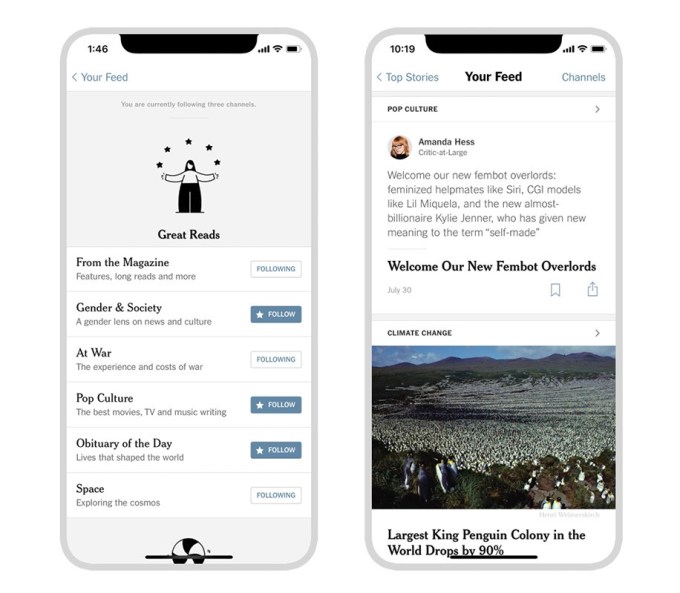
With The NYT outputting around 160 articles per day, it’s very difficult to be a comprehensive reader of the paper in its entirety, of course. But the app already allowed users to poke around in its many sections by tapping through its navigation. With the addition of a personalized feed – as on Facebook and on other social apps – there’s always the danger that people will begin to box themselves into their own news bubble. If the app’s users start skipping the front page and other key sections to hop into this own custom feed, they could potentially miss important news.
Hopefully, readers will choose to use the new Your Feed feature as something that’s additive to their overall news reading experience, and not as a stand-in for actually reading the paper itself.
Additionally, The NYT says the sections will be curated by its editors to ensure there’s a diverse selection of stories available. (Thankfully – news curation left up to A.I. and algorithms has proven time and again to be a disaster. So much so that Facebook finally gave up, and ditched its Trending news section altogether.) Plus, by having a human-programmed section, the editors can ensure not to overwhelm readers with stories.
To use the new feature, readers in the iOS app will be able to pick from one of 24 channels they want to follow – an idea that’s not too unlike the way users follow accounts on social apps like Twitter or Instagram. To then read through this section, there will now be a new space in the iOS app labeled Your Feed.
Going forward, The NYT says it will tweak the experience further by adjusting the channel selection, offering more ways to follow channels, and rolling out other features, while responding to user feedback and behavior to inform its design choices. It will also experiment with different versions of saving stories, notifications, and ways to better manage your interests in the app.
The feature is available in the The NYT iOS app on iPhone and iPad for the time being. User feedback will determine if it expands to more platforms, the publisher told us. Your Feed is available to 100 percent of users who already had the app installed, but only half of new app downloads will receive the feature, we understand.
Powered by WPeMatico
Business travelers have become an increasingly important part of Airbnb’s business, according to a new blog post. The company says that Airbnb for Work, which launched in 2014, has seen bookings triple from 2015 to 2016, and triple again from 2016 to 2017. In fact, Airbnb says that almost 700,000 companies have signed up for and booked with Airbnb for Work.
Interestingly, the breakdown of companies working with Airbnb for traveler lodging are pretty diverse — employees from large enterprise companies (5,000+ employees) and employees from startups and SMBs (one to 250 employees) take a 40-40 split, with the final 20 percent of Airbnb for Work bookings going to mid-sized companies.
In July of 2017, Airbnb started making its listings available via SAP Concur, a tool used by a large number of business travelers. Airbnb says that this integration has been a huge help to growing Airbnb for Work, with Concur seeing a 42 percent increase in employees expensing Airbnb stays from 2016 to 2017. Moreover, 63 percent of Concur’s Fortune 500 clients have booked a business trip on Airbnb.
One interesting trend that Airbnb has noticed is that nearly 60 percent of Airbnb for Work trips had more than one guest.
“We can offer big open areas for collaborations, while still giving employees their own private space,” said David Holyoke, global head of business travel at Airbnb. “We think this offers a more meaningful business trip and it saves the company a lot of money.”
Given the tremendous growth of the business segment, as well as the opportunity it represents, Airbnb is working on new features for business travelers. In fact, in the next week, Airbnb will be launching a new feature that lets employees search for Airbnb listings on a company-specific landing page.
So, for example, a Google employee might search for their lodging on Google.Airbnb.com, and the site would be refined to cater to Google’s preferences, including locations close to the office, budget, and other factors.
While the growth has picked up, Holyoke still sees Airbnb for Work as an opportunity to grow. He said that Airbnb for Work listings only represent 15 percent of all Airbnb trips.
But, the introduction of boutique hotels and other amenity-driven listings such as those on Airbnb Plus are paving the way for business travelers to lean toward Airbnb instead of a business hotel.
Plus, as mobility and relocation become even more important to how a business operates, Airbnb believes it can be a useful tool to help employees get started in a new town before they purchase a home.
Powered by WPeMatico
For being the richest company ever with $243 billion in cash, Apple sure cuts corners in the stingiest ways. The hardware giant became the first trillion-dollar company this week. Yet it’s tough to reconcile Apple earning $11 billion in profit per quarter with it still screwing us over on cords and keyboards. The “it just works” philosophy has slipped through the cracks of the money-printing machine. It’s not that Apple couldn’t afford to fix the problems, it’s just ensnared in hubris such that it doesn’t see them as important.
We still turn to Apple because it makes the best core products. But the edges of the customer experience have frayed like the wires of a Lightning cable. The key to Apple’s fortune is obviously selling high margin iPhones, not these ways it nickels and dimes us. But the company has an opportunity to raise its standards after this milestone, and win back the faith that could push it to a $2 trillion market cap.

Image via Sophia Cannon
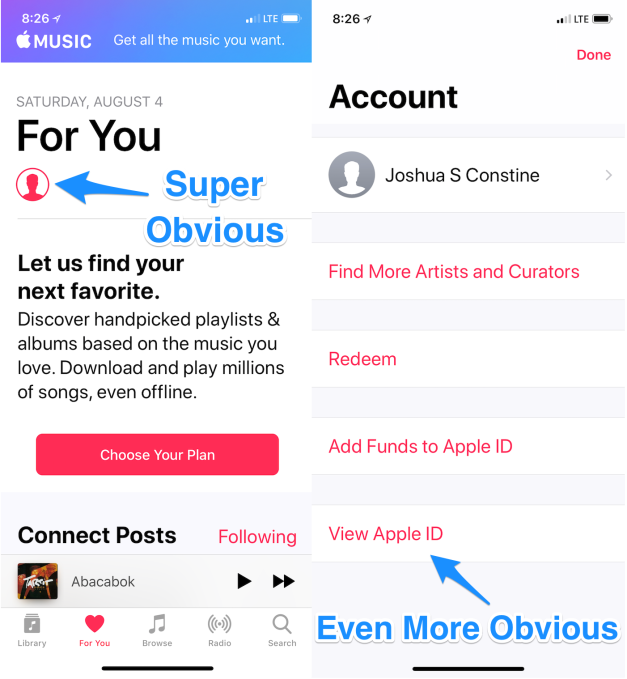

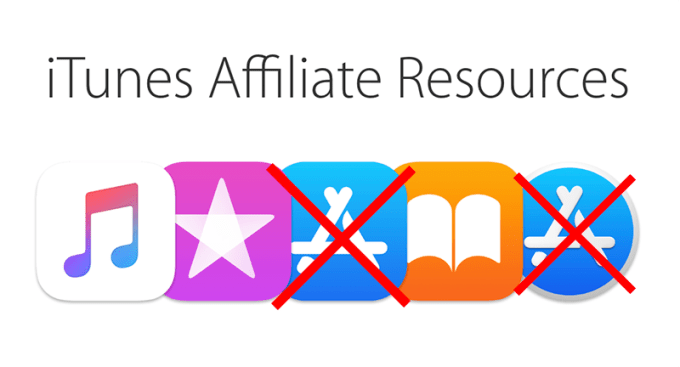

Image via Notebookcheck
[Featured Image via Instructibles]
Powered by WPeMatico
Portal founder Jonathan Swerdlin is just the latest media pundit to point to advertising as the root cause of the industry’s problems. But he’s not content to diagnose the illness — he thinks he’s created a cure.
“Digital media has become toxic, in part, because of advertising,” Swerdlin said. “The unmet and unarticulated need is a peer-to-peer economy where you’re rewarded for creating value, rather than a quantity model” where a publisher or creator’s main economic incentive is to attract as many eyeballs as possible.
Naturally, that’s what Swerdlin is trying to offer in Portal. When you open the app, you follow creators and topics that interest you, then get presented with a feed of videos. During or after the video, you can tip the creator in Portal coins — the current price is 1 cent per coin, and individual payments can be anything from 10 to 10,000 coins.
This changes the equation for creators. If you’re monetizing a video with ads, 1,000 views would represent a negligible amount of ad revenue — but if 1,000 people like the video and are willing to pay a dollar, then then you’re starting to talk about real money.
Conversely, there’s no financial incentive to post a video on Portal that gets a million views if everyone’s going to think it’s a complete waste of their time.

Swerdlin said removing advertising changes the incentives for Portal too, because the startup doesn’t benefit from promoting content just because it’ll get clicks.
In fact, he said Portal will pretty allow users to post anything, as long as it doesn’t violate community standards around things like pornography and hate speech. And it presents a purely reverse chronological feed of content based on what you follow — the question of surfacing interesting content in the feed will probably get more complicated as more users join the platform, but Swerdlin argued, “We don’t need algorithms to solve feed problems.”
“We’re not going to bury things that are not advertiser-friendly,” he added. “It’s a very different game. Portal is very much about people having a place to freely express themselves and not worry about being buried by an algorithm.”
Swerdlin acknowledged that these aren’t entirely new ideas or strategies — micropayments have been touted as a solution to media monetization for years, and he pointed to services like Netflix and Medium as offering models that help creators “break free of advertising.”
At the same time, Swerdlin said Portal’s approach to payments is truly offers “no friction” — it’s uses your App Store payment info, so you don’t even need to enter your credit information. He also said that by creating an app for content (rather than just a micropayment platform that plugs into existing websites), Portal can truly solving the problem by offering a media environment that’s “safe, it’s a healthy media diet, as opposed ot the juunk food.”
Currently, Portal’s content is limited to videos, but those videos cover a range of topics and genres like advice (personal- and business-related), comedy, music and personal vlogging. Over time, Swerdlin wants to expand to other content formats.
You also need an invite code to access the app, but if you want to try it out, feel free to use mine: “anthonyha”. (Don’t blame me; I didn’t choose it.)
Powered by WPeMatico
How should you feel to know your employer is far, far richer than Croesus?
As Apple CEO Tim Cook tells it — in a memo to staff, obtained by BuzzFeed News, re: yesterday’s news that the computer company Steve Jobs founded back in 1976 is now worth more than $1,000,000,000,000 — you should feel A) pretty stoked that your labor has helped achieve a significant financial milestone but also B) know it’s not a success metric to get hung up about because it’s the passion for innovation and creation (not the towering mounds of gold) that really counts and so C) please, after taking a moment, remember to get back to work.
Here’s what Cook actually wrote to Apple’s global “team” of circa 123,000 employees:
Team,
Today Apple passed a significant milestone. At our closing share price of $207.39, the stock market now values Apple at more than $1 trillion. While we have much to be proud of in this achievement, it’s not the most important measure of our success. Financial returns are simply the result of Apple’s innovation, putting our products and customers first, and always staying true to our values.
It’s you, our team, that makes Apple great and our success is due to your hard work, dedication and passion. I am deeply humbled by what you do, and it’s the privilege of a lifetime to work alongside you. I want to thank you from the bottom of my heart for all the late hours and extra trips, all the times you refuse to settle for anything less than excellence in our work together.
Let’s take this moment to thank our customers, our suppliers and business partners, the Apple developer community, our coworkers and all those who came before us at this remarkable company.
Steve founded Apple on the belief that the power of human creativity can solve even the biggest challenges — and that the people who are crazy enough to think they can change the world are the ones who do. In today’s world, our mission is more important than ever. Our products not only create moments of surprise and delight, they empower people all around the globe to enrich their lives and the lives of others.
Just as Steve always did in moments like this, we should all look forward to Apple’s bright future and the great work we’ll do together.
Tim
Powered by WPeMatico
Rent the Runway today announced that it has partnered with Temasek for a $200 million credit facility.
Founded in 2009, Rent the Runway lets users rent items of clothing for special events or occasions, bringing runway styles to folks without the cash to purchase the clothing outright.
Rent the Runway started out by letting users rent their wares for about 10 percent of the item’s price. But in 2017, RTR introduced a subscription model, giving users unlimited rentals for $89/month.
The model has already been proven by other businesses. RTR started giving users access to fashion in the same way that Netflix gives users access to video, Spotify gives access to music, or even the way ClassPass gives users access to studio fitness classes.
Since the subscription launch, RTR’s subscription business is up 150 percent year over year, and represents 50 percent of the company’s overall revenue.
According to the release, RTR will use the new funds to continue growing its subscription business, expand operations, and refinance its existing debt facility. As part of the deal, Temasek has received an observer seat on the board of directors.
In response to the question around why Rent The Runway chose a credit facility over traditional VC investment, CFO Scarlett O’Sullivan had this to say via email:
We are very pleased that the company has demonstrated the kind of business model, growth prospects and financial discipline that make it possible to access a credit facility of this size with an equity-minded long-term partner like Temasek – they have a proven track record of supporting disruptive high-growth companies.
We were specifically looking for debt for three key reasons:
1 – This facility gives us the ability to access more financing – we can draw capital as we need to, giving us flexibility to grow our subscription business more quickly
2 – We improved the terms of our prior facility which we refinanced with a portion of these funds — and debt for us is a lower cost option to finance the business
3 – It is less dilutive to our existing shareholders – we believe there will be significant value creation over the next several years as we continue to change consume behavior and help women put their closet in the cloud
Before this latest deal, Rent the Runway had raised more than $200 million in funding from investors such as Bain Capital, KPCB, Highland Capital, TCV, and more.
Powered by WPeMatico
“I think the mistake everyone made was to think that Stories was a photography product,” says Instagram CEO Kevin Systrom. “If you look at all these interactivity features we’ve added, we’ve really made Stories something else. We’ve really innovated and made it our own.”
His version of the ephemeral slideshow format turns two years old today. By all accounts, it’s a wild success. Instagram Stories has 400 million daily users, compared to 191 million on Snapchat, which pioneered Stories. While the first year was about getting to parity with augmented reality filters and stickers, the two have since diverged. Instagram chose the viral path.
Snapchat has become more and more like Photoshop, with its magic eraser for removing objects, its green screen-style background changer, scissors for cut-and-pasting things and its fill-in paint bucket. These tools are remarkably powerful for living in a teen-centric consumer app. But many of these artistic concepts are too complicated for day-to-day Snapping. People don’t even think of using them when they could. And while what they produce is beautiful, the slides get tapped past and disappear just like any other photo or video.
Instagram could have become Photoshop. Its early photo-only feed’s editing filters and brightness sliders pointed in that direction. Instead, it chose to focus not on the “visual” but the “communication.” Instagram increasingly treats Stories as a two-way connection between creators and fans, or between friends. It’s not just one-to-many. It’s many-to-one, as well.
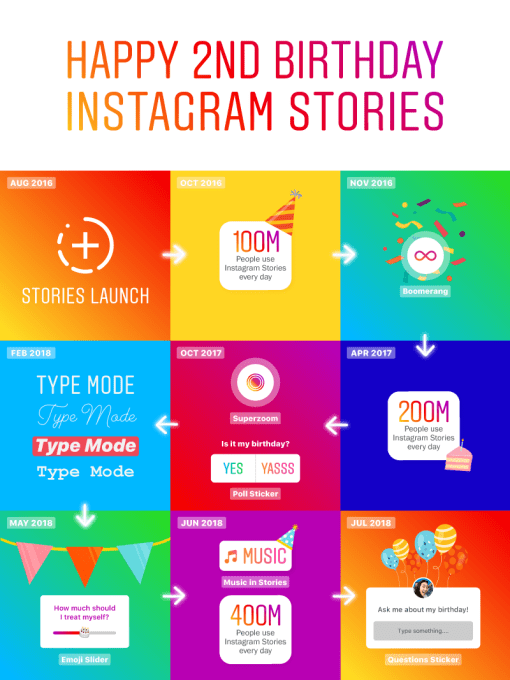
Instagram Stories arrived three years after Snapchat Stories, yet it was the first to let you tag friends so they’d get a notification. Now those friends can repost Stories you tag them in, or public posts on which they want to comment. You could finally dunk on other Instagrammers like you do with quote-tweets. It built polls with sliders friends can move to give you feedback about “how ridiculous is my outfit today?” Music stickers let you give a corny joke a corny soundtrack or share the epic song you heard in your head while looking out upon a beautiful landscape. And most recently, it launched the Question sticker so you can query friends through your Story and then share their answers there too. Suddenly, anyone could star in their own “Ask Me Anything.”
None of these Instagram tools require much “skill.” They’re designed not for designers, but for normal people trying to convey how they feel about the world around them. Since we’re social creatures, that perception is largely colored by someone’s friends or audience. Instagram lets you make them part of the Story. And the result is a product that grabs non-users or casual users and pulls them deeper into the Instagram universe, exposing people to the joy of creating something that lasts until tomorrow, not always forever.
Snap has been trying to get more interactive too, adding tagging for instance. It’s also got new multiplayer filter games called Snappables where you play with your face and can then post the footage to your Story. But again, they feel overly involved and therefore less accessible than where Instagram is going.
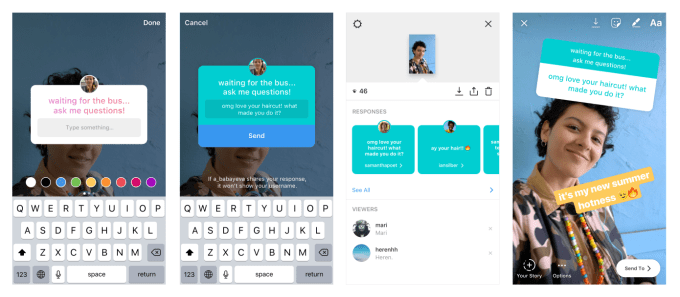
Mimicking Photoshop reinforces the idea that everything has to look polished. That’s the opposite of what Systrom was going for with the launch of Instagram Stories. “There will always be an element in any public broadcast system of trying to show off,” Systrom explains. “But what I see is it moving in the other direction. GIF stickers allow you to be way more informal than you used to be. Type mode means now people are just typing in thoughts rather than actually taking photos. Things like Superzoom with the TV effect or the beats — it’s anything but polished. If anything it’s a joke. Quantitatively people feel comfortable to post way more to Stories than to feed.”
Systrom is about to go on paternity leave, and has been using Stories from friends with kids to collect ideas about what to do with his own. When asked if he thinks Stories produces less of the dangerous envy inherent in the feeds of social media success theater we passively consume, Systrom tells me, “Just personally, it’s inspired me rather than it’s created any sense that I’m missing out.” Of course, that might be related to the fact that his life of attending the Met Gala and bicycling through Europe doesn’t leave much to envy.

AR filters have become table stakes for Stories. On the left, Instagram. On the right, Snapchat.
The sense of comfort powered by Instagram purposefully pushing Stories to diverge from its classy feed has contributed to its explosion in popularity — not just for Stories but Instagram as a whole. It now has more than 1 billion users, in part driven by it introducing Stories to developing countries Snapchat never penetrated.
“Remember how at the launch of Stories, I said it was a format and we want to make it original? And there was a bunch of criticism around us adopting this format?” Systrom chides, knowing a fair amount of that criticism came from me. “My response was this is a format and we’re going to innovate and make it our own. The whole idea there is to make it not just about photography but about expression. It’s a canvas for you to express yourself.”
At the time, Systrom also told me, regarding copying Snapchat, “They deserve all the credit.” But Stories has since emerged as how Instagram expressed itself too, allowing it to break away from the staid perfection of the feed, becoming something much more goofy.
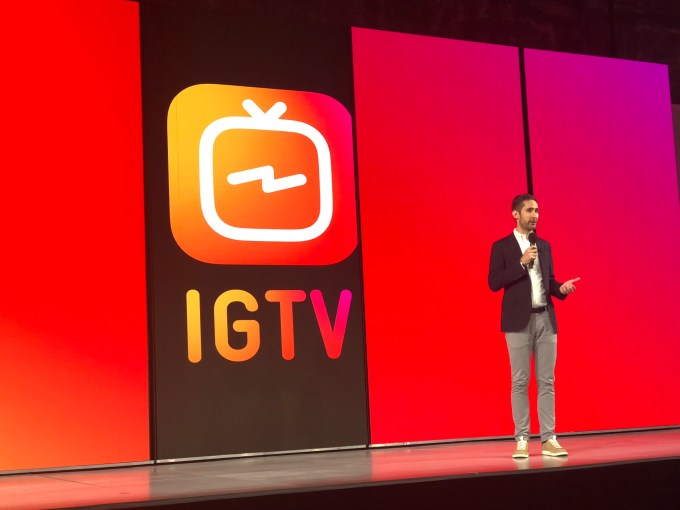
That success has emboldened it to try something truly new. IGTV lets people share longer-form vertical videos up to an hour in length in an age when vertical is for 15-second Stories and lengthy clips only exist in landscape mode.
“What I’m most proud of is that Instagram took a stand and tried a brand new thing that is frankly hard to pull off. Full-screen vertical video that’s mobile only. That doesn’t exist anywhere else,” Systrom beams. “So the question is can we pull that off, and the early signs are really good.” We’ll see if that’s born out in the numbers. Stories benefited from early adopters immediately knowing what to post thanks to Snapchat. The price IGTV pays for originality is a steep learning curve.
Last week when Facebook announced its revenue was decelerating as users shifted attention from its lucrative News Feed to Stories where it’s still educating advertisers, its share price tanked, deleting $120 billion in market cap. Yet imagine how much further it would have dropped if Systrom hadn’t been willing to put his pride aside, take Snapchat Stories, and give it the Insta spin? Instead, it led the way to Facebook now having more than 1.1 billion (duplicated) daily Stories users across its apps. That poises Facebook and Instagram to earn a ton off of Stories.
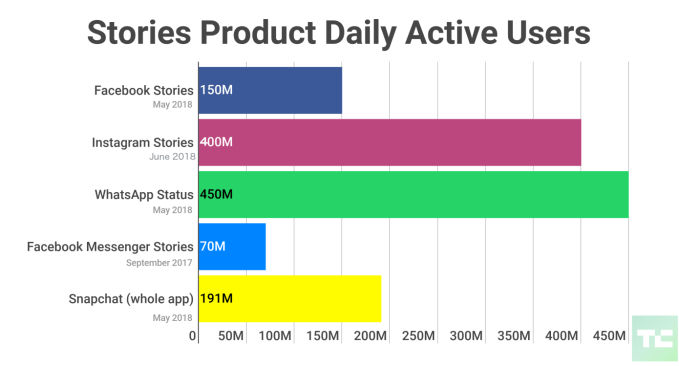
“There was a long time that desktop advertising worked really, really well, but we knew the future was mobile and we’d have to go there. There was some short-term pain. Everyone was worried that we wouldn’t monetize as well,” Systrom remembers. “We believe the future is the combination of feed and Stories, and it just takes time for Stories to get to the same level or even exceed feed.”
So does he feel vindicated in that once-derided decision to think of Stories not as Evan Spiegel’s property but a medium meant for everyone? “I don’t wake up everyday trying to feel vindicated. I wake up everyday trying to make sure our billion users have amazing stuff to use. I just feel lucky that they love what we produce,” Systrom says with a laugh. “I don’t know if that fits your definition of vindicated.”
Powered by WPeMatico
Today WhatsApp launches its first revenue-generating enterprise product and the only way it currently makes money directly from its app. The WhatsApp Business API is launching to let businesses respond to messages from users for free for up to 24 hours, but will charge them a fixed rate by country per message sent after that.
Businesses will still only be able to message people who contacted them first, but the API will help them programatically send shipping confirmations, appointment reminders or event tickets. Clients also can use it to manually respond to customer service inquiries through their own tool or apps like Zendesk, MessageBird or Twilio. And small businesses that are one of the 3 million users of the WhatsApp For Business app can still use it to send late replies one-by-one for free.

After getting acquired by Facebook for $19 billion in 2014, it’s finally time for the 1.5 billion-user WhatsApp to pull its weight and contribute some revenue. If Facebook can pitch the WhatsApp Business API as a cheaper alternative to customer service call centers, the convenience of asynchronous chat could compel users to message companies instead of phoning.
Only charging for slow replies after 24 hours since a user’s last message is a genius way to create a growth feedback loop. If users get quick answers via WhatsApp, they’ll prefer it to other channels. Once businesses and their customers get addicted to it, WhatsApp could eventually charge for all replies or any that exceed a volume threshold, or cut down the free window. Meanwhile, businesses might be too optimistic about their response times and end up paying more often than they expect, especially when messages come in on weekends or holidays.
WhatsApp first announced it would eventually charge for enterprise service last September when it launched its free WhatsApp For Business app that now has 3 million users and remains free for all replies, even late ones.
Importantly, WhatsApp stresses that all messaging between users and businesses, even through the API, will be end-to-end encrypted. That contrasts with The Washington Post’s report that Facebook pushing to weaken encryption for WhatsApp For Business messages is partly what drove former CEO Jan Koum to quit WhatsApp and Facebook’s board in April. His co-founder, Brian Acton, had ditched Facebook back in September and donated $50 million to the foundation of encrypted messaging app Signal.
Today WhatsApp is also formally launching its new display ads product worldwide. But don’t worry, they won’t be crammed into your chat inbox like with Facebook Messenger. Instead, businesses will be able to buy ads on Facebook’s News Feed that launch WhatsApp conversations with them… thereby allowing them to use the new Business API to reply. TechCrunch scooped that this was coming last September, when code in Facebook’s ad manager revealed the click-to-WhatsApp ads option and the company confirmed the ads were in testing. Facebook launched similar click-to-Messenger ads back in 2015.
Finally, WhatsApp also tells TechCrunch it’s planning to run ads in its 450 million daily user Snapchat Stories clone called Status. “WhatsApp does not currently run ads in Status though this represents a future goal for us, starting in 2019. We will move slowly and carefully and provide more details before we place any Ads in Status,” a spokesperson told us. Given WhatsApp Status is more than twice the size of Snapchat, it could earn a ton on ads between Stories, especially if it’s willing to make some unskippable.
Together, the ads and API will replace the $1 per year subscription fee WhatsApp used to charge in some countries but dropped in 2016. With Facebook’s own revenue decelerating, triggering a 20 percent, $120 billion market cap drop in its share price, it needs to show it has new ways to make money — now more than ever.
Powered by WPeMatico
It’s passive zombie-feed scrolling, not active communication with friends, that hurts our health, according to studies Facebook has been pointing to for the last seven months. Yet it’s treating all our social networking the same with today’s launch of its digital well-being screen-time management dashboards for Facebook and Instagram in the U.S. before rolling them out to everyone in the coming weeks.
Giving users a raw count of the minutes they’ve spent in their apps each day in the last week plus their average across the week is a good start to making users more mindful. But by burying them largely out of sight, giving them no real way to compel less usage and not distinguishing between passive and active behavior, they seem destined to be ignored while missing the point the company itself stresses.
TechCrunch scooped the designs of the two separate but identical Instagram and Facebook tools over the past few months thanks to screenshots from the apps’ code generated by Jane Manchun Wong. What’s launching today is what we saw, with the dashboards located in Facebook’s “Settings” -> “Your Time On Facebook” and Instagram’s “Settings” -> “Your Activity.”

Unfortunately, you’ll only see info about your usage on the mobile app on that device. It won’t include your minutes spent on desktop, where these features don’t appear, what you do on your tablet or info about your usage across the Facebook family of apps. There are no benchmarks about how long other people your age or in your country spend in the apps. All of these would make nice improvements to the dashboards.
Beyond the daily and average minute counts, you can set a daily “limit” in minutes, after which either app will send you a reminder that you’ve crossed your self-imposed threshold. But they won’t stop you from browsing and liking, or force you to dig into the Settings menu to extend your limit. You’ll need the willpower to cut yourself off. The tools also let you mute push notifications (you’ll still see in-app alerts), but only for as much as 8 hours. If you want anything more permanent, you’ll have to dig into their separate push notification options menu or your phone’s settings.
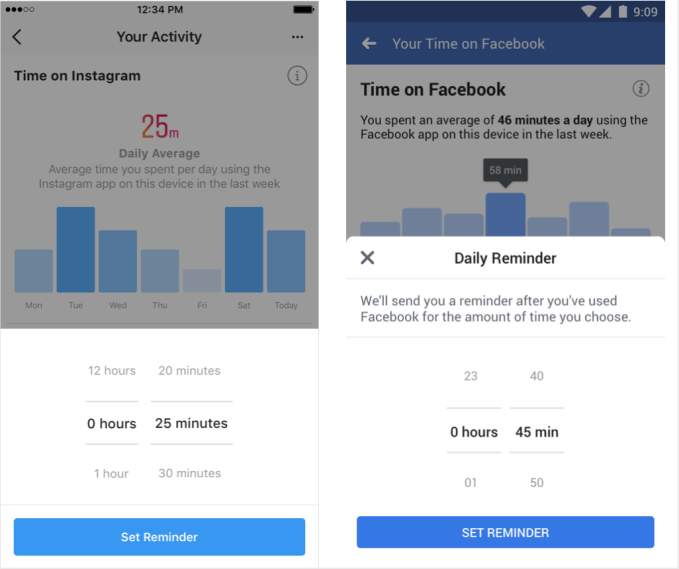
The announcement follows Instagram CEO Kevin Systrom’s comments about our original scoop, where he tweeted “It’s true . . . We’re building tools that will help the IG community know more about the time they spend on Instagram – any time should be positive and intentional . . . Understanding how time online impacts people is important, and it’s the responsibility of all companies to be honest about this. We want to be part of the solution. I take that responsibility seriously.”
Users got their first taste of Instagram trying to curtail overuse with its “You’re All Caught Up” notices that show when you’ve seen all your feed posts from the past two days. Both apps will now provide callouts to users teaching them about the new activity-monitoring tools. Facebook says it has no plans to use whether you open the tools or set daily limits to target ads. It will track how people use the tools to tweak the designs, but it sounds like that’s more about what time increments to show in the Daily Reminder and Mute Notifications options than drastic strengthening of their muscle. Facebook will quietly keep a tiny fraction of users from getting the features to measure if the launch impacts behavior.
“It’s really important for people who use Instagram and Facebook that the time they spend with us is time well spent,” Ameet Ranadive, Instagram’s Product Director of Well-Being, told reporters on a conference call. “There may be some trade-off with other metrics for the company and that’s a trade-off we’re willing to live with, because in the longer term we think this is important to the community and we’re willing to invest in it.”
Facebook has already felt some of the brunt of that trade-off. It’s been trying to improve digital well-being by showing fewer low-quality viral videos and clickbait news stories, and more from your friends since a big algorithm change in January. That’s contributed to a flatlining of its growth in North America, and even a temporary drop of 700,000 users early this year, while it also lost 1 million users in Europe this past quarter. That led to Facebook’s slowest user growth rates in history, triggering a 20 percent, $120 billion market cap drop in its share price. “The changes to the News Feed back in January were one step . . . giving people a sense of their time so they’re more mindful of it is the second step,” says Ranadive.
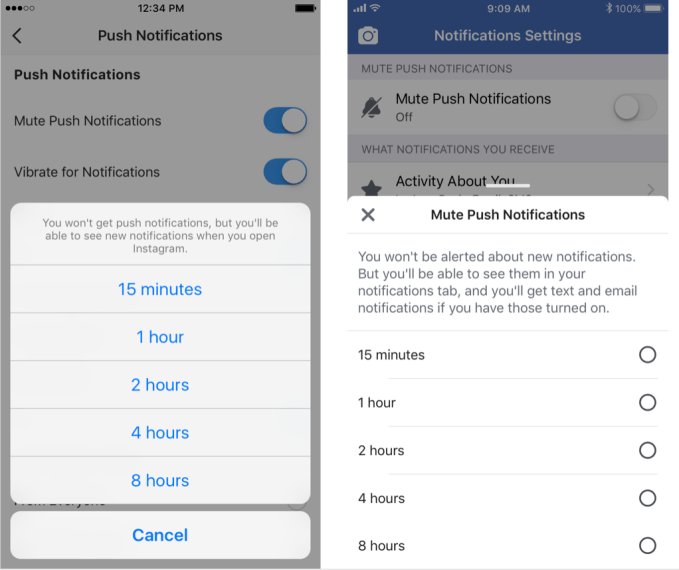
The fact that Facebook is willing to put its finances on the line for digital well-being is a great step. It’s a smart long-term business decision, too. If we feel good about our overall usage, we won’t ditch the apps entirely and could keep seeing their ads for another decade. But it’s likely to be changes to the Facebook and Instagram feeds that prioritize content you’ll comment on rather than look at and silently scroll past that will contribute more to healthy social networking than today’s toothless tools.
While iOS 12’s Screen Time and Android’s new Digital Wellbeing features both count your minutes on different apps too, they offer more drastic ways to enforce your own good intentions. iOS will deliver a weekly usage report to remind you the features exist. Android’s is best-in-class because it grays out an app’s icon and requires you to open your settings to unlock an app after you exceed your daily limit.
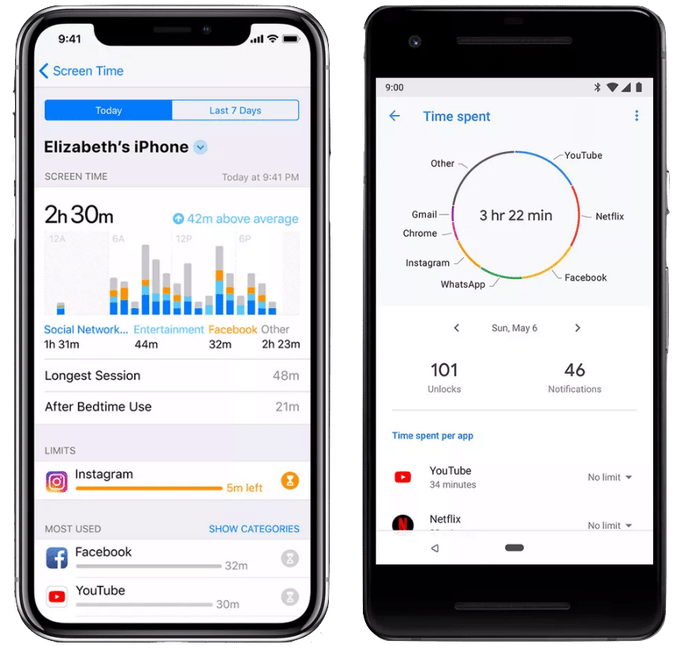
iOS Screen Time (left) and Android Digital Wellbeing (right)
To live up to the responsibility Systrom promised, Facebook and Instagram will have to do more to actually keep us mindful of the time we spend in their apps and help us help ourselves. Let us actually lock ourselves out of the apps, turn them grayscale, fade their app icons or persistently show our minute count onscreen once we pass our limit. Anything to make being healthy on their apps something you can’t just ignore like any other push notification.
Or follow the research and have the dashboards actually divide our sharing, commenting and messaging time from our feed scrolling, Stories tapping, video watching and photo stalking. The whole point is that social networking isn’t all bad, but there are behaviors that hurt. Most of us aren’t going to give up Facebook and Instagram. Even just trying to spend less time on them is difficult. But by guiding us toward the activities that interconnect us rather than isolate us, Facebook could get us to shift our time in the right direction.
Powered by WPeMatico